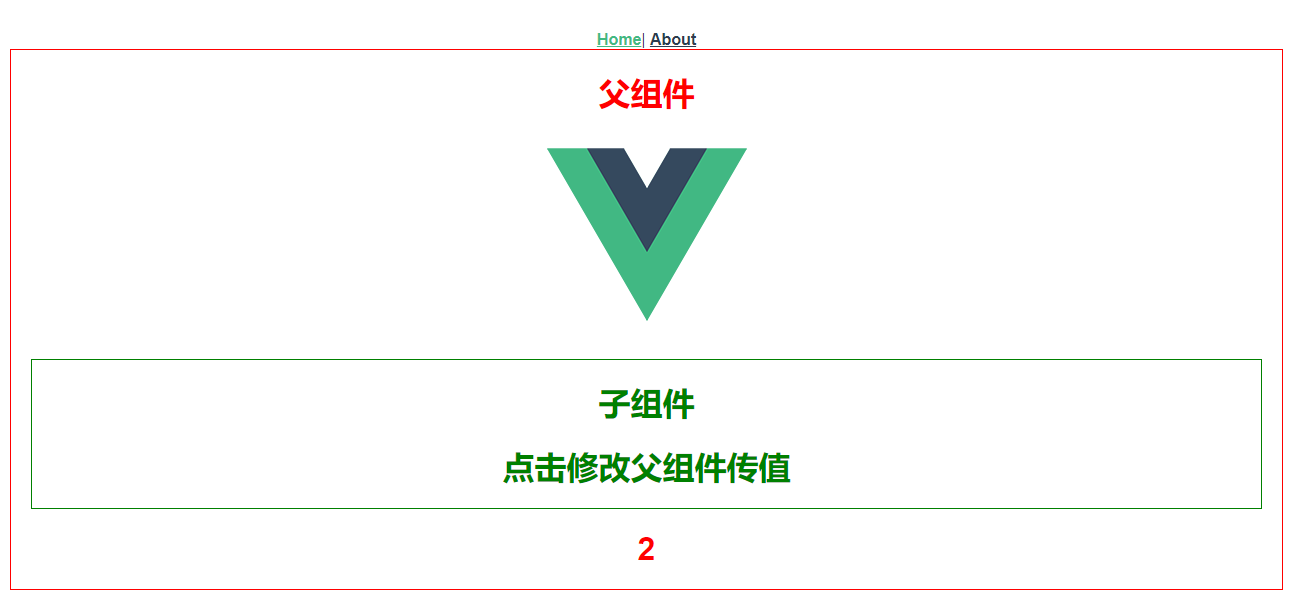vue3的新写法和特性整理——五、子组件向组件向父组件暴露方法
vue3中子组件向父组件暴露方法并传值,同样兼容老写法
1、父组件
1 2 3 4 5 6 7 8 9 10 11 12 13 14 15 16 17 18 19 20 21 22 23 24 25 26 27 28 29 30 31 32 33 34 35 36 37 38 39 | <template> <div class="home"> <h1>父组件</h1> <img alt="Vue logo" src="../assets/logo.png" /> <HelloWorld @changeMsg="changeMsg" :msg="msg" /> <h1>{{num}}</h1> </div></template><script>import { reactive, toRefs } from 'vue';import HelloWorld from '@/components/HelloWorld';export default { setup() { const state = reactive({ msg: '点击修改父组件传值', num: 0 }); let changeMsg = x => { state.num += x; }; return { ...toRefs(state), changeMsg }; }, name: 'Home', components: { HelloWorld }};</script><style scoped>.home { color: red; border: 1px solid red; }</style> |
2、子组件
1 2 3 4 5 6 7 8 9 10 11 12 13 14 15 16 17 18 19 20 21 22 23 24 25 26 27 28 29 30 31 32 33 34 35 36 37 38 | <template> <div class="hello"> <h1>子组件</h1> <h1 class="pointer" @click="notifyParent">{{ msg }}</h1> </div></template><script>import { toRefs } from 'vue';export default { setup(props, context) { console.log(context); let notifyParent = () => { context.emit('change-msg', 2); }; return { ...toRefs(props), notifyParent }; }, name: 'HelloWorld', props: { msg: String }};</script><style scoped>.hello { margin: 20px; color: green; border: 1px solid green;}.pointer{ cursor: pointer;}</style> |
setup的第二个参数中包含了 attr emit slot
其中emit用于向父组件提交事件,需要注意的是vue3中的emit中的方法名不再支持驼峰写法,但父组件依旧支持驼峰和“-”间隔的写法,
emit其余用法和vue2相同
效果图

随笔为本人学习笔记以及个人看法,若有错误,欢迎指正
本文作者:我吃柠檬
本文链接:https://www.cnblogs.com/yjc-vue-react-java/p/13876720.html
版权声明:本作品采用知识共享署名-非商业性使用-禁止演绎 2.5 中国大陆许可协议进行许可。





【推荐】还在用 ECharts 开发大屏?试试这款永久免费的开源 BI 工具!
【推荐】国内首个AI IDE,深度理解中文开发场景,立即下载体验Trae
【推荐】编程新体验,更懂你的AI,立即体验豆包MarsCode编程助手
【推荐】轻量又高性能的 SSH 工具 IShell:AI 加持,快人一步
· .NET制作智能桌面机器人:结合BotSharp智能体框架开发语音交互
· 软件产品开发中常见的10个问题及处理方法
· .NET 原生驾驭 AI 新基建实战系列:向量数据库的应用与畅想
· 从问题排查到源码分析:ActiveMQ消费端频繁日志刷屏的秘密
· 一次Java后端服务间歇性响应慢的问题排查记录
· 《HelloGitHub》第 108 期
· Windows桌面应用自动更新解决方案SharpUpdater5发布
· 我的家庭实验室服务器集群硬件清单
· C# 13 中的新增功能实操
· Supergateway:MCP服务器的远程调试与集成工具